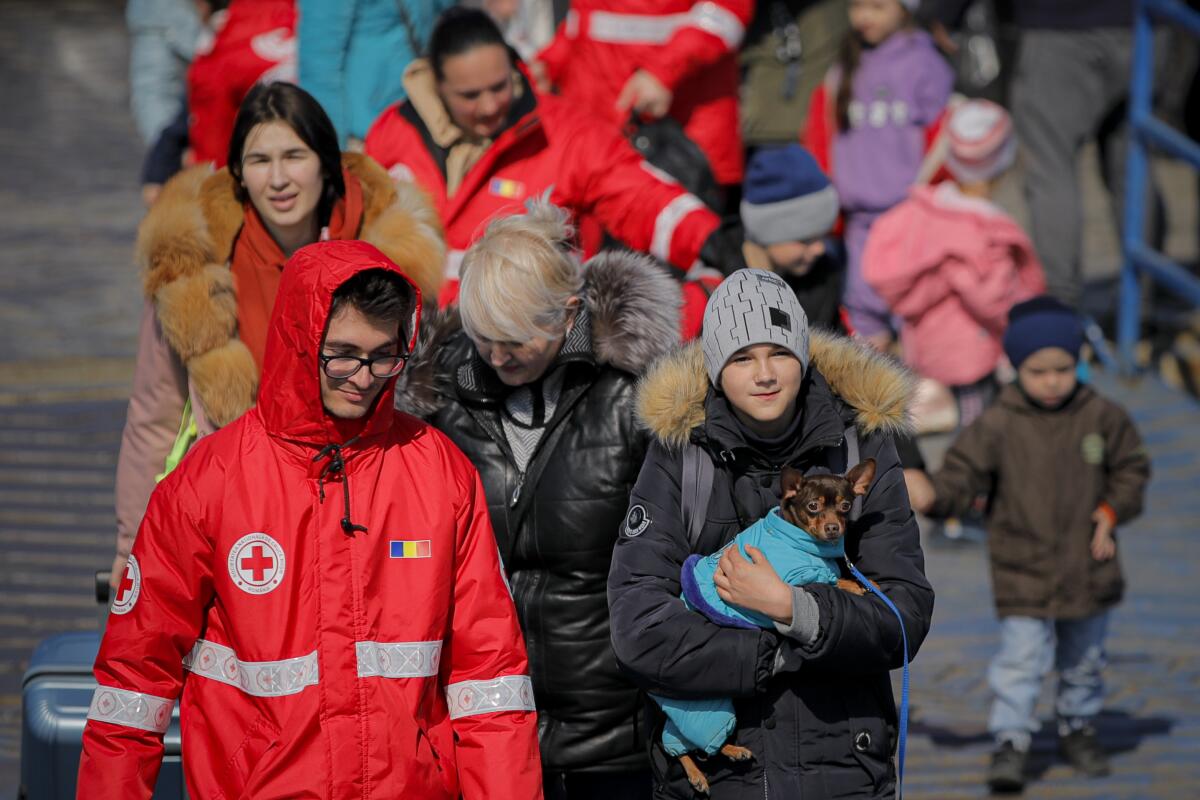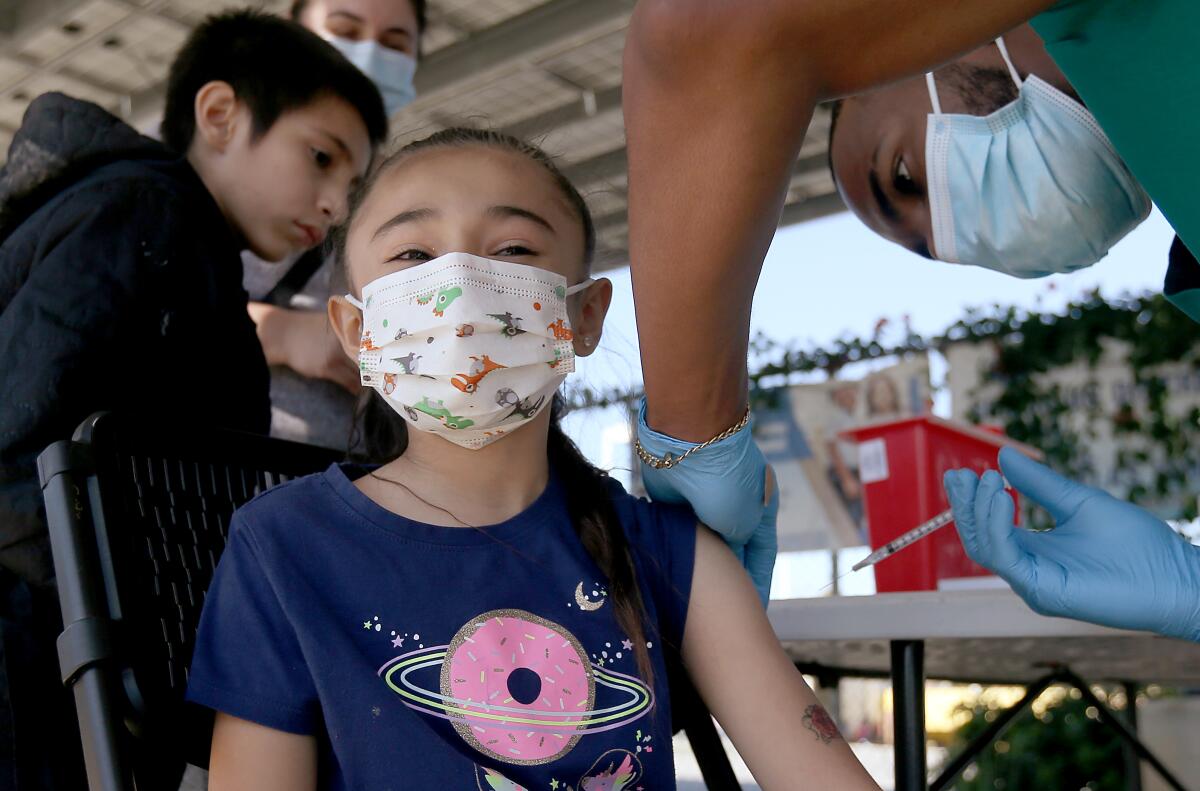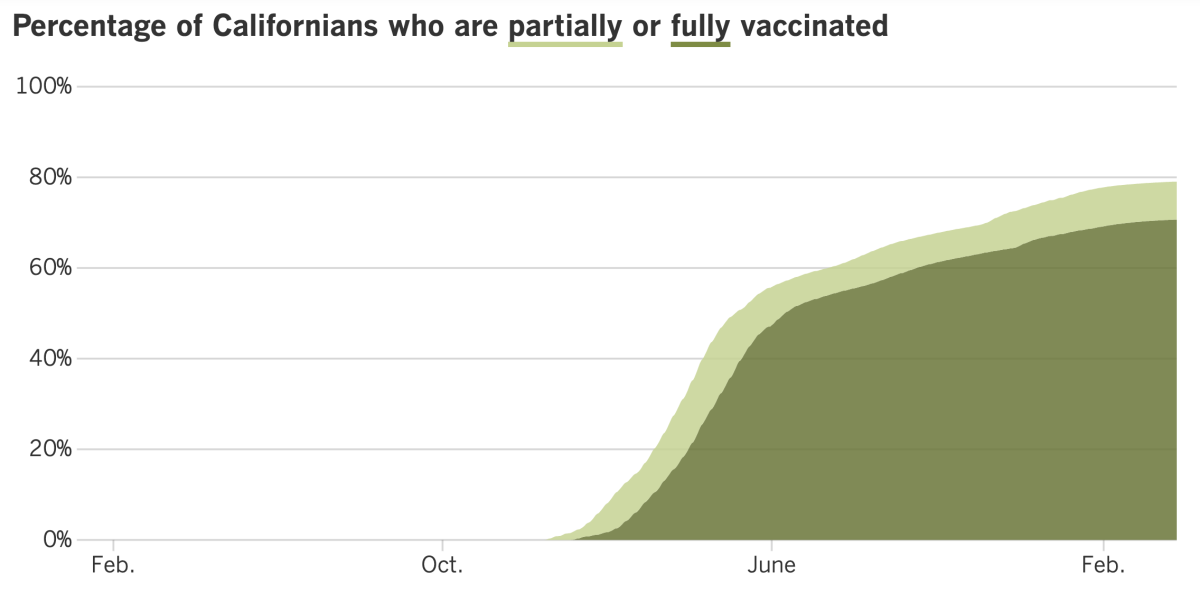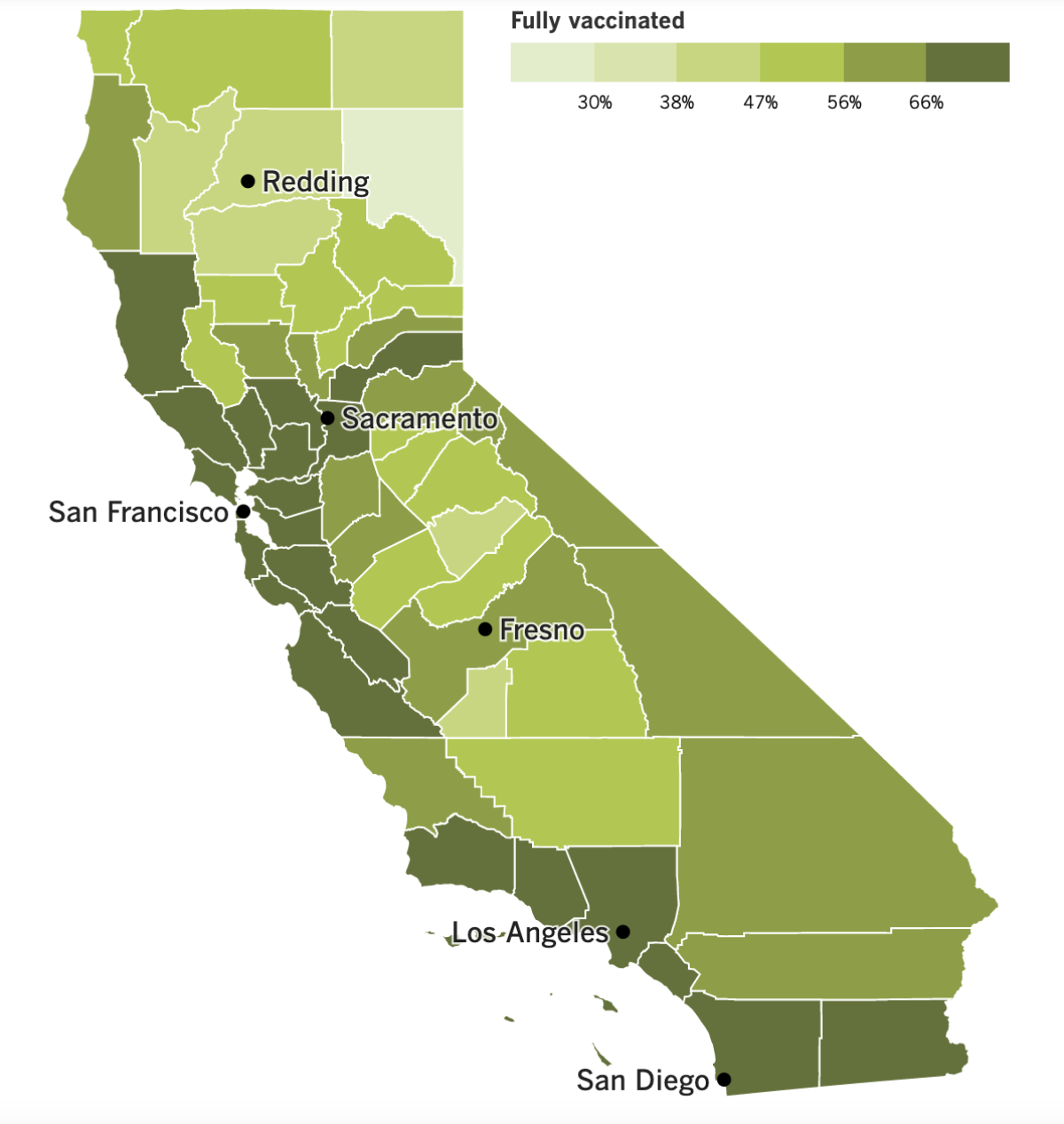Coronavirus Today: Another kind of refugee crisis
- Share via
Good evening. I’m Karen Kaplan, and it’s Tuesday, March 29. Here’s the latest on what’s happening with the coronavirus in California and beyond.
Two of the world’s biggest calamities right now are the war in Ukraine and the ongoing COVID-19 pandemic. This is a story about how they are intertwined — making both of them worse in the process.
Like the military assault, this story begins with a Russian invasion of its much smaller neighbor. Instead of sending in tanks and soldiers, the Kremlin unleashed a barrage of misinformation about vaccines.
The campaign of anti-vaccination messages began long before the pandemic, and it was designed to undermine confidence in Western-made shots as well as the governments offering them to their citizens, my colleagues Melissa Healy and Emily Baumgaertner report. The misinformation was broadcast by Russian state television and amplified on social media by Russian computer bots.
Ukraine wasn’t the sole target — President Vladimir Putin’s government targeted the former Soviet republics and other fledgling democracies across Eastern Europe. But Ukrainians were a receptive audience. The country’s childhood vaccination rates for diseases like measles and polio are among the lowest in Europe.
And when COVID-19 vaccines came along, they didn’t fare much better: Only 35% of residents were fully vaccinated when the folks at Our World in Data stopped getting updates. Experts suspect that figure actually overstates Ukrainians’ level of protection, since the vaccines available to them haven’t been uniformly effective, and those who are fully vaccinated probably aren’t boosted.
Now millions of refugees from this lightly vaccinated population have been forced from their homes and are pouring into other countries, prompting the European Center for Disease Prevention and Control to warn of “a higher risk of communicable disease outbreaks.”
The ECDC, as the agency is known, advises host countries to offer the refugees a primary or booster dose of COVID-19 vaccine. However, many of the countries taking refugees in — including Slovakia, Romania, Moldova and Bulgaria — have low COVID-19 vaccination rates too.
Slovakia has another problem: The Omicron subvariant known as BA.2 was driving a major resurgence of coronavirus infections there even before hundreds of thousands of Ukrainians arrived. Austria, Germany and the Czech Republic are in the same boat. It’s possible the refugee crisis could foment a fresh wave of COVID-19 in Europe, experts say.
That may sound like the kind of xenophobic stereotype that’s been used against migrants throughout history. But it’s worth noting that hostility toward Ukrainian refugees has been virtually nonexistent. And to make sure it stays that way, the ECDC and other health officials have taken pains to voice their concerns in ways that don’t point fingers at the people forced to flee.

The public health problem isn’t limited to the roughly 3.9 million refugees who have left their homeland. Ukrainians who are internally displaced face risks too.
To hide from Russian bombs and missiles, civilians have crowded into subway stations, theaters and other public spaces that lack heat, clean water and proper sanitation. Conditions like those are advantageous for the virus that causes polio because it spreads through oral-fecal exposure. Nearly 1 in 4 Ukrainian children aren’t vaccinated against the disease, which can cause lifelong disability or death.
Even the act of fleeing can put people in environments that give communicable diseases the upper hand.
“COVID doesn’t need crowded refugee camps to thrive,” said Dr. Chris Beyrer, the director of the Center for Public Health and Human Rights at the Johns Hopkins Bloomberg School of Public Health. “Crowded gyms, crowded buses and crowded trains will be enough.”
With the war still raging, low vaccination rates may seem to be the least of Ukrainians’ health worries. The Russian military has killed at least 1,151 civilians, including more than 100 children, and brought the care of people with life-threatening and chronic illnesses to a halt.
Still, anything that fuels the coronavirus during wartime could compound the miseries of Ukrainians, pose challenges for the countries that shelter them and, ultimately, raise the death toll.
This will “add to the litany of woes,” Beyrer said.
By the numbers
California cases and deaths as of 4:27 p.m. Tuesday:

Track California’s coronavirus spread and vaccination efforts — including the latest numbers and how they break down — with our graphics.
Some parents don’t ‘see the need’ to vaccinate young kids
Remember when parents were clamoring to vaccinate their school-age children against COVID-19? Moms and dads had gotten the shots, as had the teenagers in their lives. But until their younger children had the same protection, families didn’t feel completely safe, they said.
It’s been five months since a pediatric version of Comirnaty, the Pfizer-BioNTech vaccine, became available to children ages 5 to 11. During that time, the Omicron variant caused a record-high number of coronavirus infections and sent more children to hospitals than at any other time during the pandemic.
And yet, only 30% of L.A. County’s younger children were fully vaccinated as of the middle of March, my colleagues Emily Alpert Reyes and Phi Do report. The figure is particularly striking considering that 80% of the county’s adolescents and adults are fully vaccinated.
But it’s actually better than the nationwide average. According to the American Academy of Pediatrics, just 27% of 5- to 11-year-olds were fully vaccinated as of last week.
What accounts for the low demand?
One big factor is parents’ impression that their kids aren’t really in danger. Marie Elena Rigo, for instance, said her two kids — ages 8 and 11 — were “vibrant,” “healthy” and “fit.” But if they get vaccinated, she said, her son might develop myocarditis, an extremely rare side effect seen mostly in boys and young men.
“If my kid had a comorbidity or was at risk, that might be a different story,” the Westchester mom said. “But I just didn’t see the need.”

To be sure, in California, children younger than 18 have accounted for fewer than 1 in 5 COVID-19 cases throughout the pandemic and a scant 0.07% of all deaths, data from the AAP indicate.
Even so, the disease is riskier than the vaccine, said Dr. Paul Han, assistant chief of pediatrics at Kaiser Permanente Los Angeles Medical Center.
“I’ve seen the unvaccinated kids coming in, needing oxygen support, needing to be on a ventilator,” Han said. “I’ve seen unvaccinated kids die from complications of COVID.”
Plus, he added, a child with a mild case of COVID-19 could develop bigger problems down the road, like multisystem inflammatory syndrome or long COVID.
Jessica Calarco, an associate professor of sociology at Indiana University who has studied decision-making among moms, can understand where Rigo is coming from.
After hearing early in the pandemic that kids were at lower risk, “mothers especially clung to that message,” Calarco said. “It meant they could give themselves permission to send their kids back to school, to send their kids back to in-person child care.” And when new information emerged that might shake their sense of calm, many chose to ignore it, she said.
With just a few exceptions — most notably the Palos Verdes Peninsula, Mandeville Canyon and Palisades Highland, La Cañada and La Crescenta, and South Pasadena and San Marino — no more than half of school-age children in any part of L.A. County are fully vaccinated, according to data from the county health department.
Though vaccination rates are almost uniformly low for this age group, there are still pronounced racial disparities. As of mid-March, 59% of Asian American children had gotten at least one dose of vaccine, compared with 41% of white children, 22% of Latino children and nearly 21% of Black children, health department data show.
And in another familiar pandemic theme, vaccination rates among kids are lower in many of the poorest parts of the county.
It won’t be easy to bring those rates up. In a nationwide survey conducted last month by the Kaiser Family Foundation, 36% of parents with kids ages 5 to 11 said they would “definitely not” get their children vaccinated. An additional 9% said they’d do so “only if required.”
Health workers might change a few minds by informing parents that 5- to 11-year-olds have died of COVID-19 — 167 in this country so far. And although their risk of being hospitalized for COVID-19 is low, it’s “much higher” than their risk of getting myocarditis after being vaccinated, said Dr. Yvonne Maldonado, an infectious-disease epidemiologist at Stanford University.
Ultimately, to maximize the benefits of COVID-19 vaccines, more parents will need to adopt the outlook of Carmel Levitan, a cognitive scientist in Eagle Rock with children who are 7 and 10. She concluded that “the vaccine is almost zero risk for kids at this age” and that even a mild case of COVID-19 could lead to longer-term problems, including ones affecting the heart or the brain.
“I don’t want any of us to be getting signs of dementia 10 years earlier than we would have,” Levitan said.
California’s vaccination progress


See the latest on California’s vaccination progress with our tracker.
Your support helps us deliver the news that matters most.
In other news ...
We totally saw this coming, but it’s noteworthy nonetheless: “Stealth Omicron” is the new sheriff in town.
New estimates from the Centers for Disease Control and Prevention peg BA.2 as the primary version of the coronavirus now circulating in the United States. BA.2 accounted for 55% of coronavirus specimens over the seven-day period that ended Saturday, up from 39% the previous week.
BA.2 is most dominant in the northeastern U.S., where it makes up at least 70% of COVID-19-causing coronaviruses. In the Southwest — a region that includes California, Arizona, Nevada and Hawaii — an estimated 60.5% of specimens were of the BA.2 variety last week, up from 45% the week before.
The Omicron subvariant — which got its stealthy nickname because it lacks a mutation that usually makes it easy to distinguish Omicron from Delta — is increasing its market share because it’s even more transmissible than its predecessors. A preliminary study from Sweden posted online on Sunday reported that people infected with BA.2 had twice as much coronavirus in their noses as people infected with BA.1, an earlier Omicron subvariant.
“Higher viral load in the upper pharynx may at least partially explain why Omicron BA.2 is more contagious than the BA.1 lineage,” the study authors wrote.
Omicron has been pretty much the only coronavirus variant in the U.S. all year. Given that, the significance of BA.2 overtaking its Omicron cousins is unclear.
The number of new infections in California has been falling for weeks. A big question is whether BA.2 will allow that to continue. Some experts fear it could spark a fresh wave of cases, as it has in parts of Europe. Others say California isn’t all that vulnerable since more than 70% of residents are fully vaccinated and plenty of others have some immunity from past infections.
“I expect we’ll see a wave — I don’t know if it’ll be a surge,” Scripps microbiologist Kristian Andersen said on Twitter. “Get boosted, get those masks, and get those rapid tests.”
Speaking of boosters, millions of Americans are now eligible for a second booster dose of COVID-19 vaccine. The Food and Drug Administration on Tuesday authorized an additional booster shot for adults 50 and older who received their first booster dose at least four months ago, and the CDC updated its recommendations to bring them into alignment.
The extra shots will be available in Los Angeles County starting Wednesday.
There’s not much data to help people decide whether to take advantage of the new booster opportunity. A recent study of healthcare workers in Israel found that those who got a second booster at the height of the Omicron wave were only marginally more protected than their peers who felt one was enough. A more preliminary study of Israelis 60 and older tallied 92 deaths among more than 328,000 people who got the extra shot, versus 232 deaths among 234,000 people who didn’t.
Both the FDA and CDC made their decisions without convening their vaccine advisory groups. But additional boosters — as well new vaccine formulations designed to target specific variants — are on the agenda for an FDA advisory committee meeting next week.
If another BA.2 wave is indeed coming, Los Angeles is preparing to meet it with its guard down.
The L.A. City Council moved closer to rolling back its vaccine verification requirements for indoor restaurants, gyms, movie theaters and other businesses. By a vote of 13 to 1, council members last week backed a change in city rules that would simplify life for such businesses and their customers. Vaccine verification would also be lifted for big outdoor events. Because the vote wasn’t unanimous — Councilman Mike Bonin was the lone holdout — a second, procedural vote is necessary this week.
Schools throughout the city also took a step toward a post-pandemic future by going mask-optional. As of Wednesday, L.A. Unified’s 450,000 students and 60,000-plus employees were no longer required to wear face coverings indoors. The change was made possible by the teachers union, whose members approved the new policy by a margin of 84% to 16%.
Masks remained popular in some schools. Rafael Alvarez, the principal of Nava Learning Academy in South L.A., said 80% of his students had chosen to keep their masks on. That likely reflects the heavy toll COVID-19 has taken on the low-income community, he said.
Masked faces were in the minority elsewhere in the district. At Pomelo Community Charter in West Hills, five of 17 students in Marisa Carpentieri’s second-grade class kept their masks on, and a sixth student wore one entirely below her chin. Carpentieri was happy to remove her mask as well.
“I think it’s important to making sure the students can see the teacher’s face,” she said.
Angelenos aren’t the only ones letting their guard down. A new poll from the Associated Press-NORC Center for Public Affairs Research found that 44% of American adults “often” or “always” wear a mask around people from other households, down from 65% in January. A slightly higher number, 47%, say they avoid large groups, also down from 65% in January. And in a possible reflection of stir-craziness, 40% of those polled say they are avoiding most nonessential travel, down from 60% in January.
Overall, the results show that Americans are taking fewer COVID-19 precautions now than at any time since January of 2021, when the country was in the midst of its deadliest surge and vaccines were still extremely scarce.
That’s not good enough for Florida and 20 other states that filed a lawsuit in Tampa, Fla., on Tuesday seeking to prevent the federal government from requiring masks on planes, trains, buses and other forms of public transportation. The states argue the CDC lacks the authority to issue such a sweeping mask mandate, which has been in place since Feb. 1, 2021.
“It is well past time to get rid of this unnecessary mandate and get back to normal life,” said Florida Gov. Ron DeSantis, a Republican and vocal opponent of mask mandates.
The airline industry agrees. A trade group representing American, Delta, United, Southwest, Alaska, JetBlue and other carriers sent a letter to President Biden last week pointing to the “steady decline of hospitalization and death rates” as evidence that COVID-19 protocols could be relaxed.
“Now is the time for the administration to sunset federal transportation travel restrictions, including the international predeparture testing requirement and federal mask mandates,” the letter said.
If actions like these turn out to be premature, scientists wonder how long it will take for them to realize it.
The availability of at-home COVID-19 test kits means fewer people are taking the tests the government relies on to track viral spread, and wastewater surveillance programs aren’t ready to pick up the slack. The CDC is preparing to reduce the number of labs on the lookout for new coronavirus variants. The federal government is running out of money to pay for vaccines, testing and treatment. And although health officials are closely watching hospital admissions to see how the nation is faring against COVID-19, by the time those numbers rise, it may be too late to head off a dangerous outbreak.
Jennifer Nuzzo, a Brown University pandemic researcher, summed up the sentiment of many of her colleagues this way: “We’re not in a great situation.”
Your questions answered
Today’s question comes from readers who want to know: What’s the latest on COVID-19 shots for the youngest children?
They’re getting closer.
Last week, Moderna released early study results suggesting its kid-sized shots — which contain one-fourth the dose for adults — worked well in children ages 6 months to 5 years. Even in babies, the shots induced high levels of coronavirus antibodies, the company said.
The results were issued via news release and weren’t vetted by independent scientists. A more complete set of findings is expected in the near future.
In the meantime, Moderna said it would seek permission to offer the pediatric shots in the U.S. and Europe. A filing with the FDA could come in the next few weeks.
Pfizer and BioNTech are a week or so away from getting new results from a trial of their vaccine for infants, toddlers and preschoolers. The companies’ shots for children ages 6 months to 4 years contain a dose that’s one-tenth the size of the adult dose.
Earlier trial results found that two doses worked fine in babies and toddlers, but they weren’t enough to protect preschoolers. Instead of increasing the dose size, the companies administered a third dose. Whether it did the trick will be known in early April, but Pfizer and BioNTech already have a request for emergency use authorization on file at the FDA (at the agency’s behest).
Once the paperwork for either vaccine is complete, the FDA is expected to evaluate the clinical trial data with its scientific advisors. If one or both of the shots pass muster, the CDC will meet with its own experts and make a recommendation about who should get them.
In the best-case scenario, at least one vaccine for children as young as 6 months will be available by summer.
We want to hear from you. Email us your coronavirus questions, and we’ll do our best to answer them. Wondering if your question’s already been answered? Check out our archive here.
The pandemic in pictures

The man in red is Alex Evans, executive director and head puppeteer at the Bob Baker Marionette Theater. When Gov. Gavin Newsom shut down live entertainment venues at the dawn of the pandemic, Evans devised a multipronged plan to keep the troupe engaged with the public.
Before the puppeteers shut down their theater in L.A.’s Highland Park neighborhood, they filmed videos that could be posted online. When they went home, they each took a puppet or two so they could create public service announcements encouraging kids to wash their hands and exercise.
When the initial lockdown ended, they turned the 15-foot box truck in the photo above into a traveling theater with curtains and fold-out scenery. Before long, the “Marionette Mobile” was rolling around town like a taco truck, serving up entertainment instead of food to socially distanced audiences.
And they were just getting started.
The full story of how the Bob Baker troupe survived the pandemic is one of grit, creativity and resilience. Don’t miss this inspiring tale.
Resources
Need a vaccine? Here’s where to go: City of Los Angeles | Los Angeles County | Kern County | Orange County | Riverside County | San Bernardino County | San Diego County | San Luis Obispo County | Santa Barbara County | Ventura County
Practice social distancing using these tips, and wear a mask or two.
Watch for symptoms such as fever, cough, shortness of breath, chills, shaking with chills, muscle pain, headache, sore throat and loss of taste or smell. Here’s what to look for and when.
Need to get a test? Testing in California is free, and you can find a site online or call (833) 422-4255.
Americans are hurting in various ways. We have advice for helping kids cope, as well as resources for people experiencing domestic abuse.
We’ve answered hundreds of readers’ questions. Explore them in our archive here.
For our most up-to-date coverage, visit our homepage and our Health section, get our breaking news alerts, and follow us on Twitter and Instagram.




